Bonding with adhesives
by Matthew | 18 April 2012 10:55 am
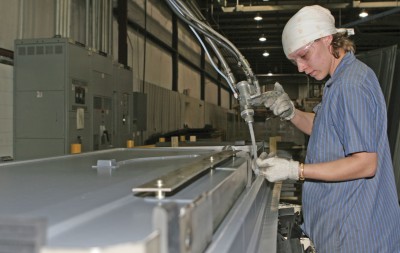 [1]
[1]Photos courtesy ITW Plexus
By Krys Wesselink
Adhesive-based bonding offers some distinctive sign-fabrication advantages that are not possible with mechanical fasteners. A well-planned adhesive application can enhance a sign’s outdoor durability, making it more watertight, airtight and impact-resistant, while also offering the opportunity for design enhancements, including the joining of dissimilar materials, unique shapes and smooth lines free of screws, rivets, clips or other fasteners. Indeed, most sign shops today use adhesive bonding for at least some of their projects.
Chemical bonds allow lighter materials to perform at higher levels, reducing both weight and cost. Shops can assemble signs less expensively, but charge a premium price for a higher-quality end product that also reduces the subsequent need for on-site repairs.
It may seem difficult at first to visualize how an adhesive bond could possibly provide superior resistance to impact and environmental forces when compared to a mechanically fixed part. Many products, however, depend on chemical bonds for this very reason, including those in the automotive industry.
Making the right choice
Adhesive selection for sign fabrication is often made at the last minute, unfortunately, with a prevailing sentiment along the lines of “we’ll just glue it,” only to find the devil is in the details and finding the appropriate product is not as easy as originally thought. To take full advantage of this technology, a bonding application should instead be determined as part of the planning process well ahead of time.
There are several issues to consider in terms of both the bonding process and the performance of the finished sign. While the number of possible combinations of substrates, production processes and client requirements is nearly infinite, the number of adhesive types is not.
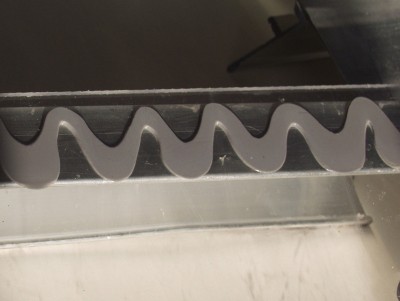 [2]
[2]Adhesives can join dissimilar materials, such as bonding polycarbonate resin thermoplastics to extruded aluminum.
So, broadly speaking, the following questions need to be answered before selecting an adhesive for a sign:
- Which materials are being used and how will they fit together?
- How will the sign be built (e.g. working vertically or laying flat) and how much time is there for the fabrication process?
- Will the sign be installed indoors or outdoors?
- What environmental factors will affect the sign?
- How much stress will it need to withstand and for how long?
Taken together, such variables as substrate materials, workflow and long-term performance may seem to conflict with each other. Achieving the right mix can be like a jigsaw puzzle, but with forethought and expert advice, what initially seems complicated will come into clearer focus.
As mentioned, adhesive bonding offers options that other methods do not. Welding, for example, cannot combine two different metals. A chemical bond, on the other hand, can be achieved not only between two different metals, but also in combinations of materials like plastics, glass and wood, in a far simpler and broader way, allowing for more creative designs.
Compared to welding, chemical bonding eliminates the worry of distorting sign substrates with heat. It also provides insulation against galvanic corrosion. Glass, in particular, would be very challenging to incorporate into sign designs without adhesives, as would any two materials with significantly different thermal expansion and contraction properties, flexibility or other physical properties.
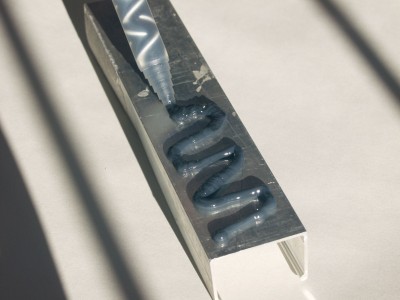 [3]
[3]It is important to choose the right adhesive for the materials being bonded.
Time and temperature
In bonding applications, two ‘countdowns’ begin as soon as the adhesives are applied or their components are mixed.
The first counts down the curing process. The second counts down ‘open’ or ‘working’ time, during which the operator can lay down the beads of adhesive and work with them, marrying the two surfaces together. After this working time ends, it will be too late to guarantee adequate adhesion between the first and second surface.
So, it is important to select an adhesive whose capabilities match the sign fabrication workflow, based on how much time the operator needs to assemble the parts and then can wait before moving them again.
Fortunately, there is usually no need to wait for full cure. Instead, it is likely sufficient to wait for ‘fixture time,’ when the bond has achieved a fair percentage of final cure strength.
Besides time, temperature is another important consideration when fabricating a sign, especially if the work processes are being handled outdoors. Ambient temperature affects all chemical reactions—heat speeds them up, while cold slows them down. So, adhesives must be applied within their specific temperature guidelines.
Ambient temperature is not the only concern in this respect. Adhesives also need to be stored at stable temperatures to ensure they remain usable, as do the corresponding sign substrates. Cold substrates can act as heat sinks and tend to develop a thin film of condensation that can prevent good adhesion.
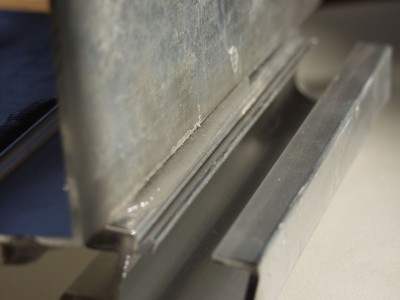 [4]
[4]Joining two aluminum extrusions, adhesives provide an alternative to welding or drilling, with no weakening of the metal.
Configuring joints and lines
Given the realities of sign design and construction, joint configurations cannot usually be changed to accommodate a particular adhesive, so instead, the adhesive needs to be appropriate for the existing sign design.
Minimum bond line thicknesses will disqualify a number of types of adhesive products. Another important factor is the type of joint, whether it is tensile, shear or peel, and whether the substrates are flanged or configured as a butt joint, in which case adhesive strength becomes a key factor. For the most part, different adhesives perform very differently depending on the nature of the stresses placed on them.
Since there is no need with adhesives to make accommodations for fasteners, sign design lines can be kept smooth and clean. Hence, bonding helps free designers to more fully explore their imaginations.
Boosting durability
When specifying a sign for durability requirements, there is a temptation to begin by focusing on bond strength. In reality, structural adhesives are generally far stronger than they need to be, so strength may not be an issue at all, depending on the particular application.
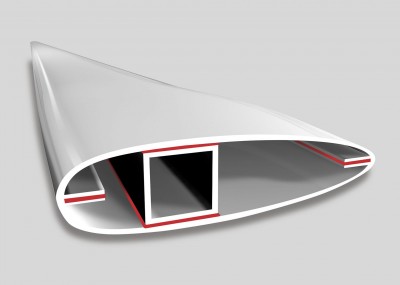 [5]
[5]Chemical bonding can liberate sign design, enabling more creative shapes and forms.
Another important advantage is the fundamental way chemical bonding reduces stress on the elements of a sign. Mechanical fixation can require the drilling of holes, the insertion of clips or the high heat levels associated with welding, all of which will weaken the underlying material and then concentrate stress at the newly created weak spot.
Signmakers are all too familiar with materials cracking or breaking at their fastening points. Bolts and screws tend to work themselves loose over time, while spot welds are prone to metal fatigue, discolouration and dimpling.
Exposed outdoor signs must endure the cumulative effects of relentless environmental elements, including thermal cycling, wind gusts, ultraviolet (UV) radiation, water and salt. These forces are a threat to a sign’s structural integrity and visual appearance.
Moisture leaks can cause serious problems for metal components and electrical sign installations, particularly through holes and block seams left when mechanical fasteners are used. The right adhesive, on the other hand, can achieve a complete seal without the need to punch holes through the sign materials in the first place.
The same property that provides the sealing action—i.e. the polymer adhesive bridging the substrate materials both chemically and mechanically—also helps to absorb and internalize the stresses caused by expansion, contraction and deflection. At the same time, the adhesive distributes the remaining forces more equally, meaning there is far less chance of breaking.
 [6]
[6]One-step adhesive systems for joining and sealing save both time and energy compared to welding.
Mechanical fixations cannot do this. Instead, they produce stress points that do not take advantage of the entire system, disassociating a sign’s structural elements, such that each individual part functions more or less separately from the others. Only a limited degree of stress can be shared through mechanical fasteners by leverage or tension.
In fact, shifting from point loads to a full-perimeter bond can turn a substrate panel into a fully functioning stress member.
Ensuring integrity
Today’s engineered adhesive products can accomplish many objectives in signmaking. A single-step bonding system not only simplifies the manufacturing process, but also helps overcome design challenges and increases durability, resulting in a fully sealed sign with cleaner lines. So long as the right adhesives are chosen, they will become an integral part of a sign shop’s work procedures.
Montreal-based Krys Wesselink is the Canadian sales manager for ITW Plexus, which manufactures adhesives. For more information, visit www.itwplexus.com[7].
- [Image]: http://www.signmedia.ca/wp-content/uploads/2014/02/Plexus-Plastic-Application-2.jpg
- [Image]: http://www.signmedia.ca/wp-content/uploads/2014/02/Aluminum-to-Lexan-2.jpg
- [Image]: http://www.signmedia.ca/wp-content/uploads/2014/02/P2085118.jpg
- [Image]: http://www.signmedia.ca/wp-content/uploads/2014/02/P2085121.jpg
- [Image]: http://www.signmedia.ca/wp-content/uploads/2014/02/Wind-blade-secrion-large-file.jpg
- [Image]: http://www.signmedia.ca/wp-content/uploads/2014/02/IMG_0687.jpg
- www.itwplexus.com: http://www.itwplexus.com
Source URL: https://www.signmedia.ca/bonding-with-adhesives/